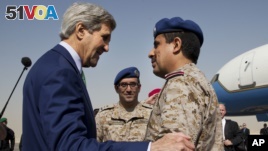Jan 10, 2017
The world is getting smaller. And that means that too often, regional conflicts and threats to peace that only a few decades ago would have quickly burned themselves out, thanks to new technologies, as well as ease of travel and global communication, can now quickly turn into a global threat.
Global threats require a global response, and that is why the United States works in partnership with other countries. But “complex challenges require new approaches to working together with U.S. allies and partners worldwide to promote international peace and security,” writes public affairs specialist at the State Department's Bureau of Political-Military Affairs David McKeeby, in a recent blog post. One way to do this is to more effectively link diplomacy and defense, thus finding new avenues by which to deliver the tools and training that strengthen our allies' capabilities to adapt and respond to these challenges.

The United States has several programs to achieve this goal. First, we offer numerous grants to help our partners invest in U.S. equipment and training, including funding for peacekeeping operations aimed at helping nations recover from conflict. The funds come from 6 billion dollars' worth of Security Assistance programs administered by the Bureau of Political-Military Affairs Foreign Military Financing.
Second, the Foreign Military Sales system is an essential U.S. foreign policy tool. It is a form of security assistance that allows the United States to transfer defense equipment and services to our partners worldwide, once the President formally finds that doing so will strengthen the security of the U.S. and promote world peace.
Then there is the Lead Nation Procurement Initiative, a pilot program that allows our NATO allies to transfer to other NATO members, military equipment purchased from the United States. The goal is to maintain flexibility, keep down costs, yet still be able to keep track of the equipment. We have also updated forty-year-old rules regarding U.S. disbursement of defense equipment and services, to speed up the delivery of spare parts.
“While we cannot see what lies ahead in 2017,” writes David McKeeby, “you can count on [the United States'] continued commitment to expanding these partnerships to meet new and emerging security challenges.”